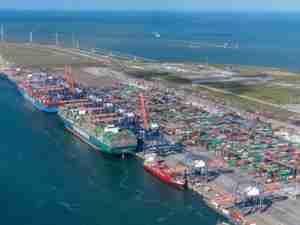Inland Port Posts Strong Volumes and Barge Traffic Increases
NORFOLK, VA – The Port of Virginia® in March processed 240,035 TEUs (twenty-foot equivalent units) in March, making is the second busiest March in the port’s history.
Though cargo was off nearly 5 percent compared with last March, the port is handling near-peak season volume, says John F. Reinhart, the CEO and executive director of the Virginia Port Authority. The average monthly volume in 2018 was 238,000 TEUs. The volume dip came as the result of five blank sailings that were a result of the Chinese New Year and four vessels that arrived late.
The port’s inland operations, Virginia Inland Port (VIP) in Front Royal and Richmond Marine Terminal (RMT) performed well: VIP volume was up 10.5 percent, or 285 containers, and RMT barge volume was up 7.3 percent, or 187 containers. Total barge volume was up nearly 37 percent or 1,334 containers. Truck volume was off nearly 10 percent and rail volume was flat.
“Our new capacity gives us the leverage we need to go out and start aggressively marketing The Port of Virginia again,” Reinhart says. “We are showcasing our new assets and capabilities to cargo owners and ocean carriers.”
600 World Trade Center I Norfolk, VA 23510 I ph (757) 683 8000 I toll-free (800) 446-8098 I portofvirginia.com
In late March, Virginia International Gateway (VIG) tested its newly-expanded capacity when it worked two 14,400-TEU and an 8,500-TEU-vessel at once.
“The team and terminal performed nicely,” Reinhart says. “We had all 12 cranes working, the new stacks operating in conjunction with TRS (Truck Reservation System) and the first phase of the rail yard were all pushed. We’re testing our new capabilities and are seeing positive results.”
The port is less than two months away from completion of construction at VIG. To date, 13 new container stacks serviced by 26 new rail-mounted gantry cranes (RMGs) have been delivered. Four new ship-to-shore cranes – presently the largest in the United States -- were placed into service within the last two weeks.
“The second phase of the rail yard is the final piece to be delivered and that will be ready in late May -- by June, we’ll be fully-operational at VIG,” Reinhart says. “The product we’re creating is world-class and we are beginning to see results in terms of improved turn-times for motor carriers, better overall cargo flow and reduced dwell times for rail boxes.”
At VIG, expanded turn times in March were about 38 minutes for motor carriers using the reservation system; traditional turn-times were about 32 minutes. Further, 27,452 moves, or 71.5 percent of the terminal’s total truck volume, were made during the reservation period, which is 4 a.m. to 1 p.m.
Across the river at Norfolk International Terminals (NIT), progress on that terminal’s south container stack- yard is also being made. Twelve of 30 new container stacks have been delivered and their performance, combined with the reservation system, had a positive effect on gate efficiency in March.
Expanded turn times under TRS at were about 44 minutes and traditional turn-times were about 39 minutes. A total of, 24,849 moves, or 68.5 percent of the terminal’s total truck volume, were made during the reservation period, which is 5 a.m. to 1 p.m.
The second phase of the South NIT stack-yard project is set for delivery in September; all construction will be complete by late 2020.
March Cargo Snapshot
- Total TEUs – 240,035, down 4.8%
- Loaded Export TEUs – 89,282, down 9.5%
- Loaded Import TEUs – 107,040, down 5.4%
- Total Containers – 135,146, down 5.4%
- Breakbulk Tonnage – 12,673 (tons), down, 34.5%
- Virginia Inland Port Containers – 3,006, up 10.5%
- Total Rail Containers – 48,933, down .6%
- Total Truck Containers – 81,027, down 9.8%
- Total Barge Containers – 5,186, up 34.6%
- Richmond Barge Containers – 2,740, up 7.3%
- Vehicle Units – 1,760 – up .2%










